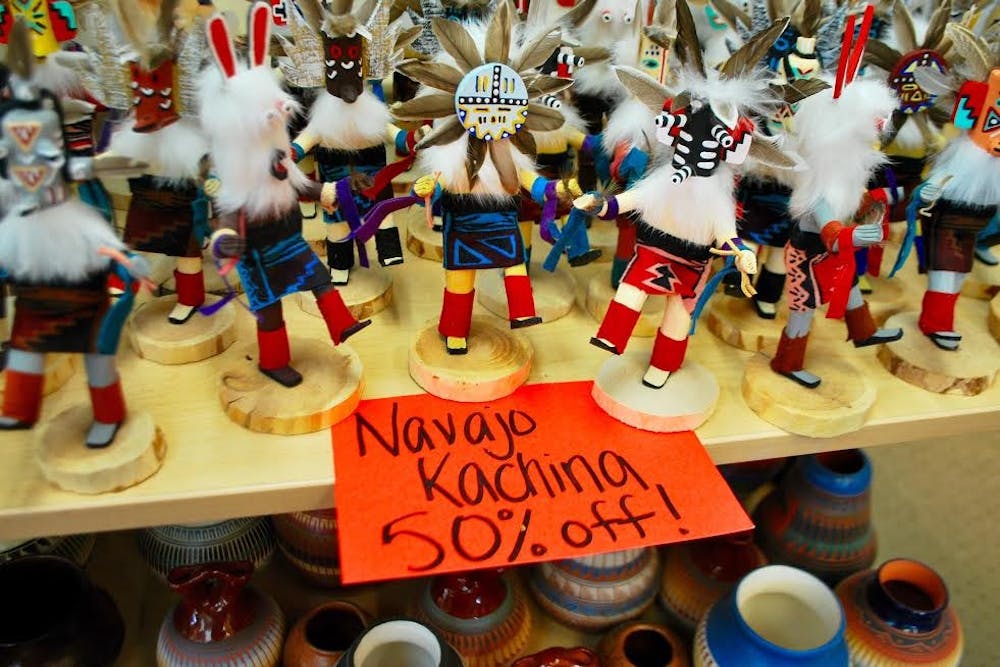Old Town Scottsdale embodies Arizonian culture in a way that is both charmingly nostalgic and embarrassingly inappropriate.
Home to any number of western-themed shops and restaurants, Old Town is a quaint reminder of our desert roots here in the Valley of the Sun.
Unfortunately, it also houses several self-proclaimed “Indian trading posts,” the existence of which indicates how entirely out of touch Old Town is with what is culturally acceptable.
Before discussing the issues with these kinds of establishments, we first need to get a clear idea of what constitutes cultural appropriation.
In its barest definition, cultural appropriation is when someone adopts elements of a culture that is not their own.
More specifically, cultural appropriation often occurs when there is an imbalanced power-dynamic in which the culture of the person adopting these elements dominates or oppresses the culture from which they are borrowing.
This power-dynamic is what separates cultural appropriation from assimilation or cultural exchange, and is often committed out of ignorance rather than ill-intent.
Even if they intend no harm, however, those who commit cultural appropriation often do so without any real understanding or reverence for the culture they are appropriating
While getting educated about the history and traditions of other cultures is alway an enriching and worthwhile endeavor, even a deep understanding of another’s culture does not guarantee a safe passage through the murky waters of what is and isn’t socially acceptable.
Whenever someone has their culture appropriated, especially if they belong to a minority, there is a risk that they will be offended based on feelings of being misrepresented, falsely empathized with, or simply made fun of.
Cultural appropriation is often scorned by the surrounding parties as well, because it is perceived as insensitive and entitled.
Some complain that society has become overly sensitive to these types of issues, but considering the history of racism we have in this country, I truly believe we cannot be too careful.
The levels of cultural appropriation in Old Town are committed in varying degrees.
To begin with, there is a basic issue with the word “Indian” being thrown around. As we all learned in grade school, “Indian” was a misnomer applied by Columbus to the indigenous people of North America.
Among the names that the indigenous people of North America generally accept are American Indian, Native American, or better yet, the specific tribe to which an individual belongs; “Indian,” however, is not one of them. (Note: It should go without saying that this is not a blanket rule, and one should always defer to the ethnic title prefered by the individual as an act of basic courtesy.)
These “trading posts” offer a variety of “Indian” items purchased from artists off the reservation or from wholesalers who “employ Native Americans.”
These items are mingled throughout the stores and marketed to tourists blindly looking for a piece of Arizonian culture to take home with them.
Among these items are dream catchers, katsina dolls, kokopelli and more, all of which have deep cultural roots of which few people are aware of.
Some of the salespeople at the stores I visited spoke of the personal relationships they have with the artists they buy from, and some made vague assurances of the items’ authenticity, while openly admitting to having a limited knowledge of the culture.
Regardless, all were united by the common fact that they are not American Indian. Not a single person I spoke with identified themselves as such.
If the cultural appropriation going on here is not yet obvious, there is also the issue of business owners in the largely white upper-class Scottsdale area taking advantage of the more limited business opportunities of the Native people.
This is not to say that these business owners are tyrannical opportunists engaging in malpractice, which I am sure is not the case. It is, however, a fact that no matter how well the artists are paid, they are not making a full amount of profit for their work because of the inevitable need of the business owner to turn a profit.
While these artists surely offer up their work voluntarily, I must assume it is because this is the best opportunity presented to them, and not because they feel this is the most effective way to share their culture. This is yet another misfortune of the racial discrimination and oppressive behavior society is still struggling to overcome everyday.
Just as there is no clear-cut enemy in this situation, there is also no clear-cut solution to the problem of cultural appropriation. It is my hope, however, that by being aware of these issues and swiftly correcting our own behavior when necessary, we can all contribute to a more conscious society that promotes cultural sensitivity and equality.
Reach the columnist at icastil3@asu.edu or follow @isabella_m_cast on Twitter.
Like The State Press on Facebook and follow @statepress on Twitter.
Editor’s note: The opinions presented in this column are the author’s and do not imply any endorsement from The State Press or its editors.
Want to join the conversation? Send an email to opiniondesk.statepress@gmail.com. Keep letters under 300 words and be sure to include your university affiliation. Anonymity will not be granted.




